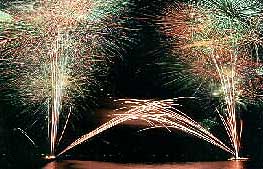|
|
Fireworks: From Here to There
When Marco Polo encountered his first firecracker during his travels in China, he thought the noise alone was enough to scare people to death. Literally. Nonetheless, he was so impressed that he brought a bunch of fireworks home to show off when he returned to Venice in 1295. The world’s been fascinated ever since.
Firecrackers were the original fireworks. The Chinese invented them some 1,500 years ago. They’d stuff a gunpowder-like mix into hollow bamboo and then light it, setting off a really loud explosion. People thought the noise warded off evil spirits, so firecrackers earned a permanent place in Chinese ceremonies. From those evolved rockets, which by the 1200s were making war.
 During the Renaissance, Europeans were refining new rocket designs to make the bright illuminations like what you’ll see on the Fourth. By the During the Renaissance, Europeans were refining new rocket designs to make the bright illuminations like what you’ll see on the Fourth. By the
mid 1600s fireworks had become the ultimate party favor in Europe.
In 1776, one day before America’s Declaration for Independence was signed, John Adams predicted that colorful "illuminations," as fireworks were known back then, would erupt all over the nation to celebrate the Fourth by future generations. By the mid 1800s, America was hooked on the fiery Independence Day tradition we know and love today.
How They Blow
The fireworks we watch in the skies each Fourth of July are called skyrockets. The big ones can be three feet in diameter and weigh 700 pounds. Even today, all fireworks are hand-made; machinery might spark the black powder and blow a crater in the ground where the fireworks factory used to be. Workers aren't even allowed to comb their hair at work or wear certain fabrics; the static electricity might set off explosives.
Basically, skyrockets are paper cylinders stuffed with special gunpowder mixes, tightly packed chemical balls and fuses.
The main fuse lights a gunpowder mix that rockets the firework skyward out of a metal or cardboard launch tube. Smaller timed fuses on the inside set off the thunderclaps, crackles, sparkles and colorful explosions in midair.
The color comes from metallic salts mixed into the chemical balls. Copper mixes, for instance, burn blue and green.
How the balls and explosive charges are arranged inside determines whether the firework explodes as a disc, starburst, weeping willow or some other funky pattern.
Save Your Fingers
To shoot off the biggest rockets, you've got to be a licensed pro who's gone through years of apprenticeship before being allowed to light any fuses.
In the early 1900s, more people were hurt or killed by mishandling fireworks in one year than in the whole Revolutionary War. Go figure.
Today in Maryland, only the smallest of fireworks are legal, and some counties don't allow fireworks of any sort. M-80s and cherry bombs are now illegal all over the U.S. because they've blown off so many fingers and hands.
Even legal fireworks must be handled very carefully.
Wanna go see fireworks?
Check out our lead story to find out where!
Copyright 2001
Bay Weekly
|